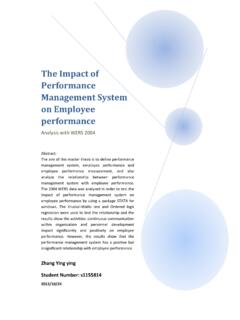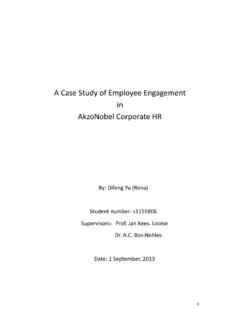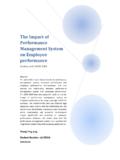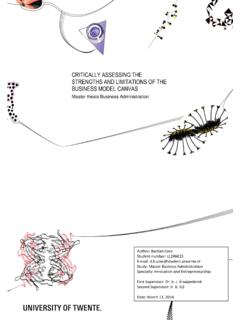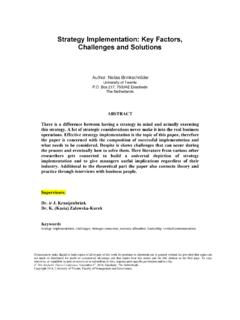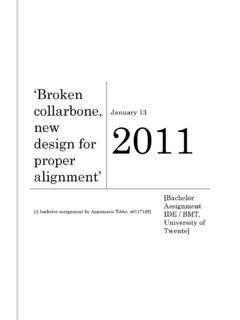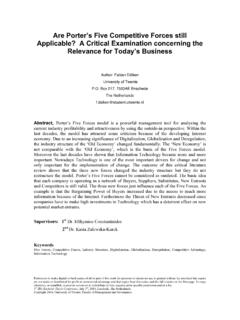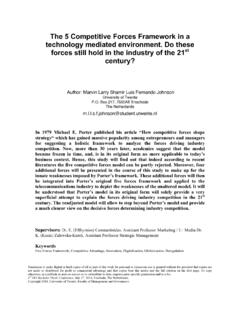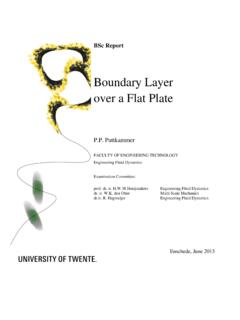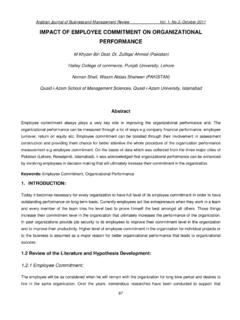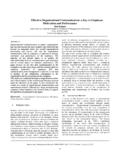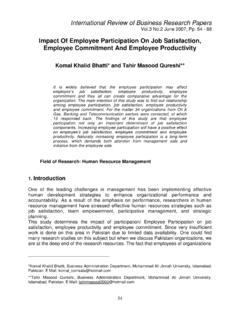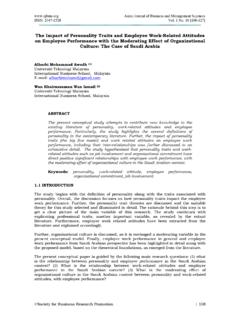Transcription of Assessing Affective Commitment in the T hree-Component ...
1 Running Head: Assessing Affective Commitment Assessing Affective Commitment in the Three-Component Model and the Two Factor Theory: A Comparison between the Theories of Meyer and Allen and Herzberg, Mausner and Snyderman Rianne Kaptijn (0044563) Master thesis Occupational and organizational Psychology Supervisors: Prof. dr. K. Sanders and Dr. Geurts University of Twente Date: 16-01-2009 Assessing Affective Commitment 1 ABSTRACT The purpose of this paper is to contribute to the empirical evidence concerning Affective Commitment by Assessing the three-component model (Meyer & Allen, 1991) and the two factor theory (Herzberg, Mausner & Snyderman, 1959). Using survey data from 167 stores and 4112 employees from Poland and 191 stores and 6136 employees from the Czech Republic it is found that the three-component model predicts the simple and mediating effects reasonably well.
2 Especially work experiences appear to have a large influence on Affective Commitment . The interaction effects from both theories were found antagonistic using this data. The model does not fit the data when all confirmed hypotheses are combined to one model. There were no higher order effects, neither from supermarket nor country. For future research a conceptual model with better defined constructs and sub constructs, that are more compatible with the hygiene and comfort factors, would be fruitful. Keywords: Affective Commitment , Three-component model, Two factor theory, Work experiences, Supermarket Assessing Affective Commitment 2 Assessing Affective Commitment in the three-component model and the two factor theory A comparison between the models from Meyer and Allen and Herzberg, Mausner and Snyderman Scholars who study the efficiency and effectiveness of an organization, for example scholars in the field of industrial- organizational psychology, economics, marketing and management, have become increasingly interested in organizational Commitment .
3 This is not surprising since organizational Commitment is found to be empirically related to economical concepts like job performance (Mowday, Porter, & Dubin, 1974; Steers, 1977), absenteeism (Sagie, 1998), turnover intentions and cognitions ( , Angle & Perry, 1981; Porter, Steers, Mowday, & Boulian, 1974), job satisfaction (Bluedorn, 1982; Eby, Freeman, Rush & Lance, 1999; Tett & Meyer, 1993) and to more recently developed psychological constructs like organizational citizenship (O Reilly & Chatman, 1986; Shore & Wayne, 1993). In an attempt to synthesize the organizational Commitment research Allen and Meyer (1990) and Meyer and Allen (1991) analysed an extensive amount of Commitment literature. In both reviews they define organizational Commitment as a psychological state that characterizes the relationship that the employee has with the organization; a relationship that influences the decision of the employee to stay in or leave the organization.
4 In the same articles they conceptualize three distinguishable components of Commitment . The first component, Affective Commitment has three subcomponents 1) the emotional attachment to the organization 2) the identification with the organization and 3) the involvement in the organization. Employees that are strong Affective committed want to stay employed in the organization. The second component, continuance Commitment refers to perceived costs when the employee would leave the organization. Employees with this kind of Commitment stay employed in the organization because they need to be. The third component, normative Commitment concerns a perceived obligation to stay with the organization. Employees that are strong normative committed stay in the organization because they believe they ought to. Hackett, Bycio and Hausdorf (1994) and Allen and Meyer (1996) argued that there was enough evidence regarding the construct validity of the three components of organizational Commitment .
5 In 2002 a meta analysis of empirical studies from Meyer, Stanley, Herscovitch and Topolnytsky showed that the three components of Commitment are related yet distinguishable from one another. Assessing Affective Commitment 3 Allen and Meyer (1990) and Meyer and Allen (1991) argued that it is likely that the three conceptual different components of Commitment have different antecedents and different implications for work relevant behaviour other than turnover. Based on this idea they created the three-component model of organizational Commitment . The model is mainly based on induction, only a small part of the model is based on empirical evidence (Meyer & Allen, 1991). Up till now the three-component model is seen as the dominant model in organizational Commitment ( , Bentein, Vandenberg, Vandenberghe, & Stinglhamber, 2005; Cohen, 2003; Greenberg & Baron, 2003).
6 To date, empirical research has shown that Affective Commitment predicts employee performance (Meyer, Paunonen, Gellatly, Goffin, & Jackson, 1989), absenteeism (Sagie, 1998), turnover (Tett & Meyer, 1993) and organizational citizenship (Meyer, Stanley, Herscovitch, & Topolnytsksy, 2002; Organ & Ryan, 1995) better than the other components of Commitment . However there is no consensus about the causal ordering and the strengths of the relationships between all the antecedents and between the antecedents and Affective Commitment (Bateman & Strasser, 1984; Brown & Peterson, 1993; Curry, Wakefield, Price & Mueller, 1986; Vandenberg & Lance, 1992). The purpose of this paper is to contribute to the empirical evidence concerning Affective Commitment by Assessing the extent to which the antecedents predict Affective Commitment and especially evaluate the role of the moderating and mediating factors in the three-component model (Meyer and Allen, 1991) and the two factor theory Herzberg, Mausner and Snyderman (1959).
7 Because Affective Commitment predicts better then the other components of Commitment , this is the main focus in this paper. The model of the antecedents of Affective Commitment as Meyer and Allen (1991) proposed is presented in Figure 1. The solid lines represent the hypotheses tested in this paper, the dashed lines are left out of the analyses. The whole three-component model of organizational Commitment from Meyer and Allen (1991) can be found in appendix 1. The idea from Reichers (1985) and Becker (1992) that ( Affective ) Commitment is not unidimensional and has different foci, is followed in this paper. They suggest to measure different foci of Commitment because employees can be committed to different individuals and targets, for example: supervisor, colleagues and team. Therefore this papers focus is on Affective Commitment to work, colleagues and supermarket Assessing Affective Commitment 4 Figure 1.
8 Part of the three-component model of organizational Commitment from Meyer and Allen (1991). Note. The solid lines represent the hypotheses tested in this paper. According to Meyer and Allen (1991) work experiences have the strongest and most consistent positive relationship with Affective Commitment . They refer to Herzberg (1966) to make a distinction between the comfort and the competence categories in work experiences. To clarify this, the two factor theory of job satisfaction from Herzberg, Mausner and Snyderman (1959) is here explicated first, later on the explanation of Meyer and Allen s (1991) three-component model is continued. The two factor theory of job satisfaction from Herzberg et al. (1959) is developed on the basis of the occurrence of events (critical incidents) technique. The theory distinguishes between dissatisfiers (hygiene factors) and satisfiers (motivational factors) of a job.
9 The hygiene factors or dissatisfiers are intrinsic to a job, these are: working conditions, policies and administrative practices, salary and benefits, work itself, supervision, subordinates, peers, status, job security, co-workers and personal life. The motivational factors or satisfiers are comparable to the self-actualisation need from Maslow s hierarchy of needs (Maslow, 1943) and are extrinsic to a job. These factors are recognition for achievement, work itself, possibility of growth, advancement, responsibility and job challenge. This distinction between the satisfiers and the dissatisfiers is made because factors that lead to job satisfaction are different from factors that lead to job dissatisfaction. This means that the opposite of job satisfaction is not job Behavioral Commitment Work experiences -Comfort -Competence Causal attribution Affective Commitment organizational structure characteristics Personal characteristics Turnover Personal responsibility Assessing Affective Commitment 5 dissatisfaction but no job satisfaction, and the opposite of job dissatisfaction is not job satisfaction but no job dissatisfaction; satisfaction and dissatisfaction thus are on different continua (Herzberg, 1968).
10 According to Herzberg et al. (1959) the absence of hygiene factors creates job dissatisfaction but the presence of hygiene factors does not create satisfaction or motivation. Employees are not satisfied when hygiene factors are absent however when they are present the satisfaction is only temporary and they will begin to strive to more satisfaction; hygiene factors can only produce short term changes in job attitudes and do not enrich a person s job. In contrast to the hygiene factors the motivating factors are associated with long term positive effects in job attitudes; they enrich a person s job. According to the theory the hygiene factors must be on a minimum level before the motivating factors can be used to stimulate a person. The motivating factors can only satisfy an employee if the hygiene factors are sufficient. This is called an interaction effect; the effect of the motivating factor is dependent on the level of the hygiene factor.
